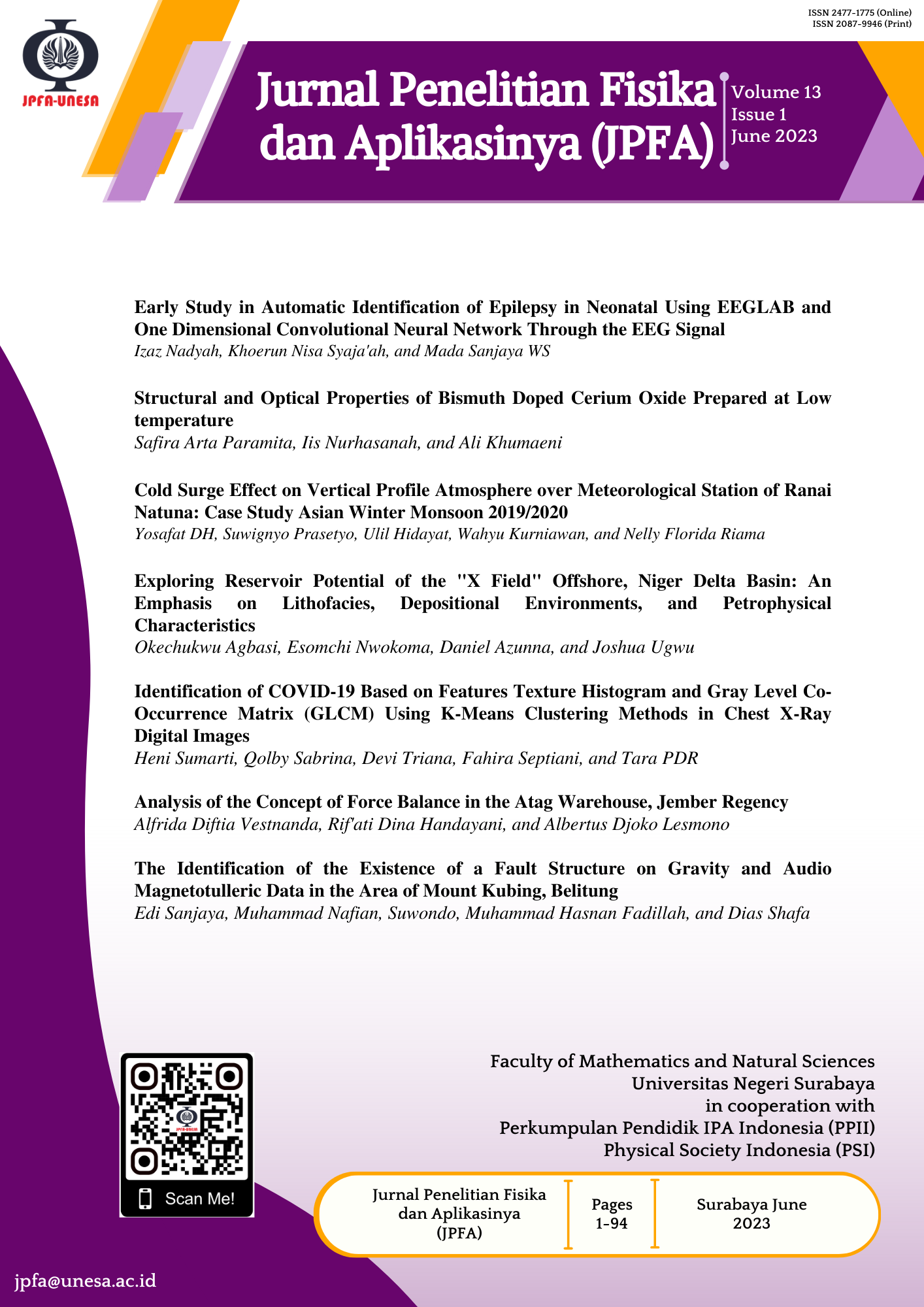Structural and Optical Properties of Bismuth-doped Cerium Oxide Prepared at a Low Temperature
DOI:
https://doi.org/10.26740/jpfa.v13n1.p16-24Keywords:
CeO2, Precipitation method, ultrasonic irradiation, structural properties, optical propertiesAbstract
Cerium oxide (CeO2) is a functional material with excellent physicochemical properties. Its properties can be modified by doping with different elements, including bismuth, which can be done through various synthesis methods. The precipitation method combined with ultrasonic radiation was used to synthesize bismuth-doped cerium oxide (CeO2:Bi) at a low temperature of 200oC. In this study, we investigate the alteration of structural and optical properties of as-prepared CeO2:Bi by subjecting it to additional calcination at a high temperature of 500oC. The structural and optical properties of CeO2:Bi were characterized using thermal gravimetric analysis, X-ray diffraction, Scanning Electron Microscope-Energy Dispersive X-Ray, Fourier Transform Infrared spectroscopy, and UV-Visible spectroscopy. The additional calcination produced a less significant weight-loss percentage than the as-prepared CeO2:Bi observed from the gravimetric curve. The Fourier transform infrared spectrum revealed the loss of a small number of hydroxyl molecules trapped on the CeO2:Bi surface when additional calcination was subjected. Based on the X-ray diffraction spectra, additional calcination results in the smallest crystallite size and compressive strain without the changed cubic crystal structure of CeO2:Bi. The successful doping of Bi in CeO2 was confirmed by the composition analysis from Energy Dispersive X-Ray measurement. Scanning electron microscope image showed spherical and agglomerated particles of calcined CeO2:Bi. The optical properties of both CeO2:Bi possessed similar trend absorption spectra and almost the same band gap energy. The results indicated that the calcination of as-prepared CeO2:Bi at a temperature of 500oC did not affect its structural and optical properties significantly. Thus, combining ultrasonic radiation with precipitation is an advantageous method to synthesize at a low temperature of stable CeO2:Bi crystalline.
References
Spiridigliozzi L. Doped-Ceria Electrolytes Synthesis, Sintering and Characterization. Switzerland: Springer Cham; 2018. DOI: https://doi.org/10.1007/978-3-319-99395-9.
Pujar MS, Hunagund SM, Desai VR, Patil S, and Sidarai AH. One-Step Synthesis and Characterizations of Cerium Oxide Nanoparticles in an Ambient Temperature via Co-Precipitation Method. AIP Conference Proceedings, 2018; 1942: 050026. DOI: https://doi.org/10.1063/1.5028657.
Wang F, et al. Effect of Cerium Oxide on Phase Composition, Structure, Thermal Stability and Aqueous Durability of Sodium-Iron-Boron-Phosphate Based Glasses. Journal of Nuclear Materials. 2021; 556: 153199. DOI: https://doi.org/10.1016/j.jnucmat.2021.153199.
Mauro M, et al. Cerium Oxide Nanoparticles Absorption through Intact and Damaged Human Skin. Molecules. 2019; 24(20): 3759. DOI: https://doi.org/10.3390/molecules24203759.
Sun X, et al. Surface Protonic Conductivity in Chemisorbed Water in Porous Nanoscopic CeO2. Applied Surface Science. 2023; 611(A): 155590. DOI: https://doi.org/10.1016/j.apsusc.2022.155590.
An K, et al. Synergistic Reinforcement Coating with Anti-Corrosion and UV Aging Resistance by Filling Modified CeO2 Nanoflakes. Colloids and Surfaces A: Physicochemical and Engineering Aspects. 2021; 625: 126904. DOI: https://doi.org/10.1016/j.colsurfa.2021.126904.
Iqbal A, et al. Biogenic Synthesis of CeO2 Nanoparticles and Its Potential Application as an Efficient Photocatalyst for the Degradation of Toxic Amido Black Dye. Environmental Nanotechnology, Monitoring and Management. 2021; 16: 100505. DOI: https://doi.org/10.1016/j.enmm.2021.100505.
Ditlopo N, et al. From Khoi-San Indigenous Knowledge to Bioengineered CeO2 Nanocrystals to Exceptional UV-Blocking Green Nanocosmetics. Scientific Reports. 2022; 12(1): 3468. DOI: https://doi.org/10.1038/s41598-022-06828-x.
Murugadoss G, Ma J, Ning X, and Kumar MR. Selective Metal Ions Doped CeO2 Nanoparticles for Excellent Photocatalytic Activity under Sun Light and Supercapacitor Application. Inorganic Chemistry Communications. 2019; 109: 107577. DOI: https://doi.org/10.1016/j.inoche.2019.107577.
Ansari AA and Kaushik A. Synthesis and Optical Properties of Nanostructured Ce(OH)4. Journal of Semiconductors. 2010; 31(3): 033001. DOI: https://doi.org/10.1088/1674-4926/31/3/033001.
di Lauro C. Rotational Structure in Molecular Infrared Spectra. Netherlands: Elsevier; 2013. DOI: https://doi.org/10.1016/C2012-0-03393-5.
Al-Otaibi AL, Howsawi E, and Ghrib T. Structural and Optical Characteristics of Pure and 5%RE (Tb, Y and Eu) Doped ZnO. Nano-Structures and Nano-Objects. 2020; 24: 100551. DOI: https://doi.org/10.1016/j.nanoso.2020.100551.
Ashraf R, Riaz S, Kayani ZN, and Naseem S. Effect of Calcination on Properties of ZnO Nanoparticles. Material Today: Proceedings, 2015; 2(10B): 5468-5472. DOI: https://doi.org/10.1016/j.matpr.2015.11.071.
Gahrouei ZE, Imani M, Soltani M, and Shafyei A. Synthesis of Iron Oxide Nanoparticles for Hyperthermia Application: Effect of Ultrasonic Irradiation Assisted Co-Precipitation Route. Advances in Natural Sciences: Nanoscience and Nanotechnology. 2020; 11(2): 025001. DOI: https://doi.org/10.1088/2043-6254/ab878f.
Downloads
Published
How to Cite
Issue
Section
License
Copyright (c) 2023 Jurnal Penelitian Fisika dan Aplikasinya (JPFA)

This work is licensed under a Creative Commons Attribution-NonCommercial 4.0 International License.
Author(s) who wish to publish with this journal should agree to the following terms:
- Author(s) retain copyright and grant the journal right of first publication with the work simultaneously licensed under a Creative Commons Attribution-Non Commercial 4.0 License (CC BY-NC) that allows others to share the work with an acknowledgement of the work's authorship and initial publication in this journal for noncommercial purposes.
- Author(s) are able to enter into separate, additional contractual arrangements for the non-exclusive distribution of the journal's published version of the work (e.g., post it to an institutional repository or publish it in a book), with an acknowledgement of its initial publication in this journal.
The publisher publish and distribute the Article with the copyright notice to the JPFA with the article license CC-BY-NC 4.0.
 Abstract views: 702
,
Abstract views: 702
, PDF Downloads: 711
PDF Downloads: 711









